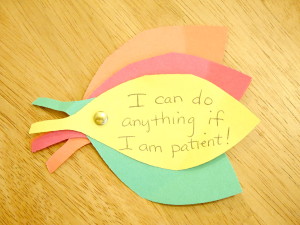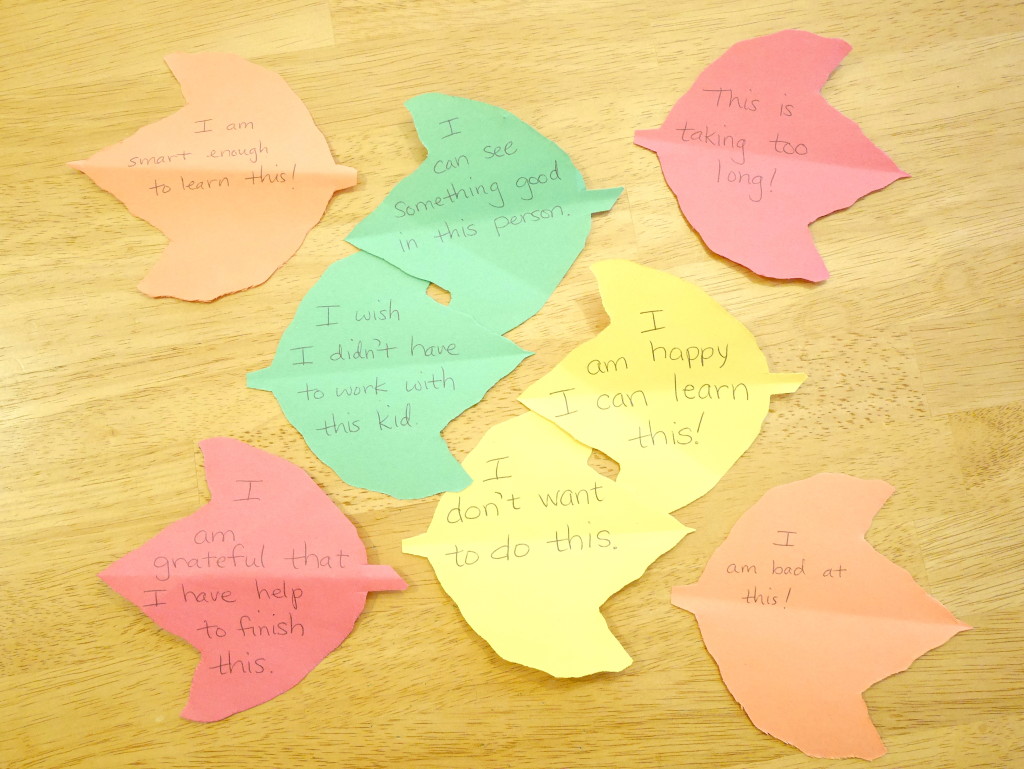This is the time of year that I LOVE doing projects!! It can be a nice break from the constant demands of academic thinking, but it is also hard for me to justify the classroom time unless I can connect it to some other learning. I loved the classic Thanksgiving projects that are so popular and easy! Just write a few things you’re thankful for on some colored leaves and tack them on the wall in a tree-formation. This project lost some steam with me over the years because I realized that we never really looked at it after we put the leaves up. I didn’t really see any changes in my students’ attitudes either. This year I wanted to do something different- something that would help kids to increase their emotional IQ – Thinking Thankfully!
When I taught first grade I used to have a “positive-thinking train” and a “negative-thinking train” posted on a wall or bulletin board. The positive-thinking train cars had positive thoughts to counter every negative thought on the negative-thinking train. The positive-thinking train went uphill while the negative thinking train went downhill in the opposite direction. I liked the visual analogy of positive thinking taking you higher and negative thinking bringing you down. I applied this idea to a thanksgiving project which you could do a couple of different ways. Just modify it to your liking!
You will need colored paper, scissors, pencils; and possibly glue, a hole punch, pipe-cleaners, binder rings, fasteners or paper clips. Die cut several leaves for each student or have them cut their own (older kids). There are tons of free leaf outlines online that you can either print on colored paper or have students decorate themselves.
The project basically consists of writing opposite thoughts (positive and negative) on opposite sides of each leaf so that students can learn to change negative thoughts into a positive association. Some common examples are below.
“This work is too hard!” – “I am grateful that I can ask for help and get it.”
“I hate doing homework.” – “I am grateful that I will have enough practice to ace my next test!”
“I hate it when I feel bullied.” – “I am grateful to have one person, ______, who will stand up for me.”
“This subject is so boring.” – “I am grateful that there a few subjects in school I like.”
“I can’t do this.” – “I am grateful to feel confident in ____.”
“I stink at this!” – “I am grateful to be good at ____.”
“____ (person) is aggravating me right now.” – “I am grateful to have other people to talk to or play with.”
You may need to change the phrasing to simplify or elaborate the sentences depending on the age of your students. Kids might need a lot of help to come up with positive thoughts for each negative one, but try to use their own ideas as much as possible so they own the work. Negative thoughts can be very personal and individual. Brain-storming ideas can be done as a whole group, small groups, partners, or individually. They aren’t going to immediately switch to this kind of thinking, so the second component of this project is to make the leaves accessible after they are created. Just like using Marzano scales in the classroom, students need to have a visual reminder of their goal while they work on getting there. Display the leaves somewhere that students can refer to as a class or individually when they notice they’re getting negative. Some ideas…
Create a Thanksgiving Tree bulletin board and have the children attach the leaves in a way that they can flip them over to see both sides. Ask students to visit the tree when they are getting negative and look for a positive alternative response to repeat to themselves. (If you choose this, set up guidelines about who, when, and how long students can visit the board so it doesn’t become an interruption.) Kids could also make their own tree by attaching leaves onto separate pipe-cleaner stems and twisting them together to make a tree. (see the photo).
Create a Thanksgiving Chart by dividing a chart paper into one half and writing the positive and negative statements on either side. Decorate the outside of the chart with fall themes. (This option is great for little kids who need teacher guidance through most activities.)
 Create a Thanksgiving Chain and attach the leaves loosely to a ribbon or string. Hang sections of the string on a bulletin board or above the students heads in one area where they can reach and review them.
Create a Thanksgiving Chain and attach the leaves loosely to a ribbon or string. Hang sections of the string on a bulletin board or above the students heads in one area where they can reach and review them.
 Create a Thanksgiving Book and have each student keep their own private collection of leaves in their desk. They can attach them using a paper clip or binder ring which will allow them to add more leaves as they think of more ideas. I recommend this for older kids so they can really become independent at referring to them as needed.
Create a Thanksgiving Book and have each student keep their own private collection of leaves in their desk. They can attach them using a paper clip or binder ring which will allow them to add more leaves as they think of more ideas. I recommend this for older kids so they can really become independent at referring to them as needed.
There is always more than one way to modify a new idea, so make it work for you in your own classroom. I’d love to hear how it goes for you! Maybe you’d like to share a related idea of your own. Leave a comment or link to your project in the reply section below.
Thank you to Margie C. for this comment from my TpT Store regarding:
“I found this product to be invaluable. It saved me so much time. Thank you!!!”
November 4, 2015
 Fun at home: My kids and I, mostly I, made this thanksgiving wreath out of dollar store stems, ribbons, wire, painted pinecones, a hot glue gun and a cardboard ring for the base. We tried to think of different things to be grateful for as we glued each stem onto the wreath. It cost about $25 and was really fun to arrange! Share about your favorite holiday projects below. I’d love some new ideas myself.
Fun at home: My kids and I, mostly I, made this thanksgiving wreath out of dollar store stems, ribbons, wire, painted pinecones, a hot glue gun and a cardboard ring for the base. We tried to think of different things to be grateful for as we glued each stem onto the wreath. It cost about $25 and was really fun to arrange! Share about your favorite holiday projects below. I’d love some new ideas myself.







